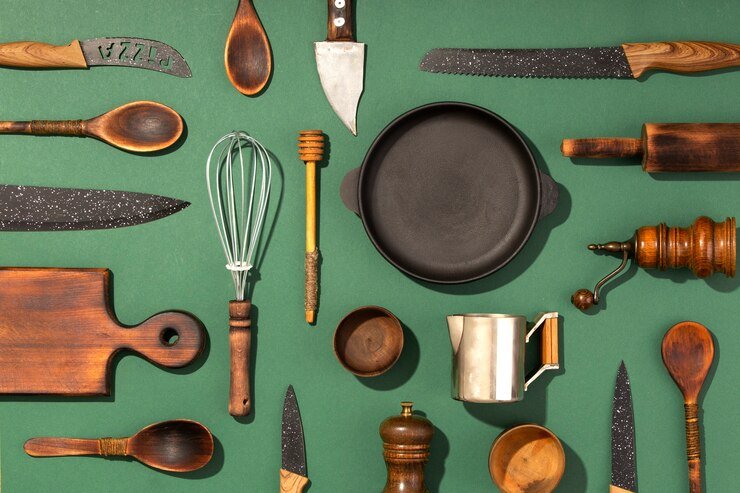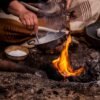A Kitchen Time Machine
Picture this: You walk into a medieval kitchen. The air is smoky from a hearth fire, the walls are lined with iron hooks, and on the table lies a heavy wooden mortar. Surprisingly, much of what you’d see would still feel familiar. That’s the magic of medieval kitchen tools: they connected cooks from centuries ago to the pots, pans, and gadgets we casually use today.
While technology has given us microwaves and blenders, the heart of cooking remains timeless. Some tools never disappeared; they simply adapted, becoming the cast-iron skillets, rolling pins, or ladles we use now.
Why Medieval Kitchen Tools Still Matter
It’s easy to dismiss old tools as relics. But the truth is, medieval kitchens laid the foundation for how we cook today. From bread baking to brewing, from preserving meat to making sauces, many traditions still echo through these tools. They matter because:
-
They shaped cooking techniques we still rely on.
-
They preserved flavors in ways machines can’t always match.
-
They connect us to cultural heritage and shared food traditions.
When we talk about medieval kitchen tools, we’re not just talking about objects—we’re talking about continuity. The way our ancestors kneaded dough or stirred stews still influences how we cook Sunday roasts, holiday pies, or family soups.
Tools of the Medieval Kitchen That Survived
1. The Mortar and Pestle
Imagine crushing garlic or grinding spices without electricity. In medieval kitchens, the mortar and pestle was essential. Herbs, grains, and even medicines were ground this way. Today, chefs still prefer it for pesto or curry pastes, saying it releases oils and flavors better than a blender ever could.
2. Cast-Iron Cauldrons and Pots
The bubbling cauldron wasn’t just a fairytale image it was the medieval version of today’s stockpot. Hung over an open fire, it cooked stews, porridges, and broths for entire households. Our modern cast-iron Dutch ovens and soup pots trace their lineage directly back to these sturdy vessels.
3. Bread Ovens and Baking Stones
Bread was life in the Middle Ages. Ovens made of clay or stone turned simple dough into the staple food of Europe. Today, pizza stones, brick ovens, and sourdough revivalists carry forward this medieval legacy. If you’ve ever baked on a stone slab, you’ve essentially stepped into medieval shoes.
4. Knives and Cleavers
Sharp blades were the backbone of food prep then as now. Butchers, bakers, and household cooks relied on them daily. The shape of a chef’s knife today isn’t far removed from medieval versions—only the steel has improved.
5. Spits and Roasting Tools
Think of a medieval feast, and you’ll imagine a pig roasting on a spit. Rotisseries were staples in castle kitchens. Modern grills and rotisserie ovens carry this tradition forward, even if we now roast chickens instead of whole boars.
6. Wooden Spoons and Ladles
Every grandmother’s kitchen has a wooden spoon. Medieval kitchens did too. Simple, durable, and heat-resistant, wooden utensils haven’t lost their charm. Some cooks swear their sauces taste better when stirred with wood rather than metal.
7. Rolling Pins
Flatbreads, pies, and pastries were all part of medieval diets. Rolling pins were sometimes as simple as a round stick flattened dough, then, just as they do today.
8. Butter Churns
In rural households, butter was made by hand with churns. While few of us churn butter at home today, the design hasn’t changed much. Artisanal food lovers still use small churns to make butter with old-world flavor.
Table: Medieval Tools and Their Modern Counterparts
| Medieval Tool | Use in the Middle Ages | Modern Equivalent / Use Today |
|---|---|---|
| Mortar & Pestle | Grinding herbs, grains, spices | Making pesto, spice mixes, and pastes |
| Iron Cauldron | Stews, broths, communal meals | Cast-iron Dutch oven, soup pots |
| Baking Stone / Oven | Bread and flatbreads | Pizza stones, brick ovens |
| Knives & Cleavers | Butchering, chopping, carving | Chef’s knives, cleavers |
| Spits & Roasters | Roasting meats at feasts | Rotisserie ovens, BBQ grills |
| Wooden Spoon / Ladle | Stirring soups and sauces | Wooden and silicone utensils |
| Rolling Pin | Flattening dough for bread/pies | Modern rolling pins |
| Butter Churn | Making dairy products | Artisanal butter churns |
What History Tells Us
Historical texts like The Forme of Cury (a 14th-century English cookbook) show just how integral these tools were. The Smithsonian and National Geographic also highlight how tools like mortars and cauldrons shaped medieval diets, which leaned heavily on grains, legumes, and preserved meats.
Archaeologists frequently unearth fragments of pots, knives, and baking stones in medieval ruins, proving just how central these tools were to daily survival. Some finds even show wear marks identical to the scratches on pots in modern kitchens.
Experience: Cooking Like They Did
I once tried making bread on a clay baking stone heated in an outdoor fire. The crackling crust and smoky flavor were unlike anything from a modern oven. Friends said it “tasted old”—but in the best way. That moment reminded me that medieval cooks weren’t just surviving; they were creating flavor experiences that still inspire us.
Surprisingly, many families in rural Europe still use versions of these tools. In Italy, wood-fired ovens are common. In parts of France, stone mortars remain kitchen staples. The line between medieval and modern is thinner than we think.
Why They’ve Survived
When you step back, you realize these tools didn’t survive by accident. They survived because they work.
-
They’re durable: stone, wood, and iron last for decades.
-
They’re effective: slow grinding or roasting brings out deeper flavors.
-
They’re cultural: tools passed down as heirlooms carry meaning beyond function.
In a world of gadgets and electricity, these ancient designs remind us that the simplest tools often deliver the most enduring results.
What This Really Means
Medieval kitchen tools aren’t relics locked in museums. They’re living reminders in our kitchens today. Every time you use a rolling pin, stir with a wooden spoon, or simmer soup in a cast-iron pot, you’re reenacting centuries of history.
It’s not just about nostalgia. It’s about realizing that cooking has always been a shared human experience. The hands that rolled dough in the 13th century aren’t so different from yours.
FAQs About Medieval Kitchen Tools
Q1: Do people still use medieval kitchen tools today?
Yes, many have modern versions. Mortars, wooden spoons, cast-iron pots, and rolling pins remain essential worldwide.
Q2: Which medieval tool is most unchanged?
Probably the mortar and pestle. Its design hasn’t changed in thousands of years.
Q3: Why are these tools still popular?
They’re durable, effective, and often provide better flavor or texture than machines.



